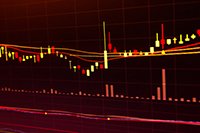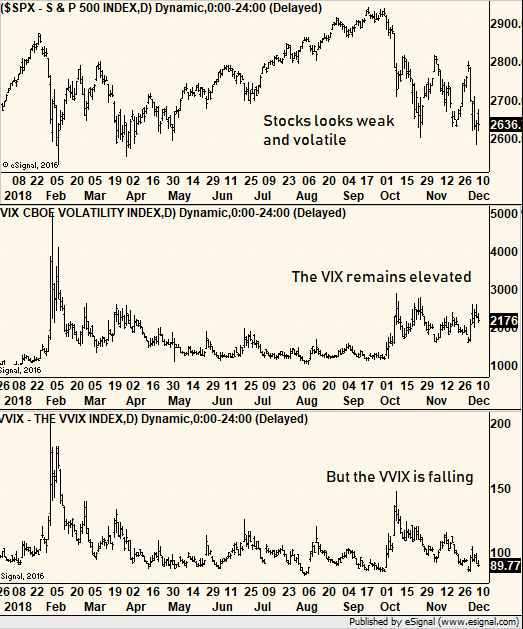Money Morning readers tell us they are worried about a recent spike in market volatility, especially with stocks taking a beating over the last week.
Fortunately, we have tools that can tell us whether volatility will continue to rise like it did in February or if we're due for another low.
Most of us think volatility means danger for investors. After all, when the Dow swings hundreds of points higher and lower in the same trading session, it is very hard to know what to do.

But volatility is not necessarily evil.
If fact, without volatility, stocks would not move, and no one would make any money. The idea is to understand that volatility is not out to get you. In fact, with the right tools, you can use it to make a fortune on stocks.
Let's first define what volatility really is.
And then we'll show you a tool we can use to predict whether stock market volatility will get worse or better in 2019...
Why Rising Volatility Has Traders Nervous
Volatility, or "historical volatility," is defined in the statistics books as the variance between stock prices and their average price. This is because it uses an average price calculated from past, or historical, prices. For example, the calculation can use data from the past 20 trading days.
Myth Busted: The biggest myth in all of investing could be costing you THOUSANDS. It doesn't matter what the markets do next - as long as you see this.
Don't worry about the hard-core math and statistical terms like variance and standard deviation. The only thing to worry about is how far the price of your stock moves from its average price. The more it moves away from that average, the more volatile it is. And the more volatile it is, the more likely it will make a big move over time.
Of course, the more it moves, the more profits - and losses - it can deliver.
The risk is that we don't know which way it will move when it does, which is exactly why rising volatility has traders and investors alike squirming.
The other type of volatility is called "implied volatility," and it's a bit more complicated. It's derived from options pricing, where the current options prices, strike prices, and time to expiration come together to tell us what the volatility must be.
In other words, if the spread of shorts and calls being placed on stocks grows, then it implies volatility is rising.
Implied volatility is the basis for the CBOE Volatility Index (VIX). The VIX looks at near-the-money S&P 500 options' implied volatility and massages them to create the VIX value.
Low levels of VIX suggest low volatility, and usually that means low levels of fear in the market. Investors are not willing to pay up for options protection.
Conversely, high levels of VIX suggest more fear. And really high levels suggest extreme fear, if not panic.
With the VIX rising since October, traders are concerned about what it means for future stock prices.
If the VIX keeps rising, then stocks could enter a bear market. Or worse.
And if the VIX settles back down toward 2018 lows, then we could see a renewed rally in stocks.
Fortunately, there's a tool we can look at that will help us know which direction the VIX will head next.
Armed with this one little tidbit of market knowledge, you can make a tidy profit, whether it's trading VIX options or knowing when to add stocks to your portfolio or get defensive.
And right now, it's showing us that the Wall Street pundits have it all wrong...
Your Secret Weapon to Profit from Volatility
[mmpazkzone name="in-story" network="9794" site="307044" id="137008" type="4"]
Traders can look at the volatility of the VIX index itself. This index, called the VVIX, can foreshadow changes to come in the underlying VIX.
Here's how it works.
If you throw a ball up in the air, it will start to decelerate, thanks to gravity. It will climb higher until the force of the throw is no longer as strong as gravity, pulling the ball back down. Eventually, the ball stops moving higher and drops.
We know the ball will come back down - we just don't know when.
Think of volatility rising like the ball flying through the air. If we know volatility will keep rising while stocks keep falling, then it might be time for traders to get out to stave off even worse losses.
But if we know that volatility will settle down - the ball returning back to earth - then it might be time to buy back in.
The VVIX gives us a way to see whether volatility will continue to rise, or is about to settle down.
And right now, the VVIX says markets should settle down soon.
Take a look at a chart of the S&P 500, the VIX, and the VVIX in the current market.

As you can see, the market was a beast over the past three months, with huge swings higher and lower and moves in and out of correction territory (loss of 10% from the peak). The VIX was elevated, as we would expect during such an environment.
However, the VVIX is actually contracting and has been doing so for much of the market's correction. That suggests traders are not worried about volatility climbing much higher, and they actually expect it to contract.
That means you can get an edge on the market by knowing volatility will likely fall soon.
That's one of the secrets some of the best traders in the world use to get an edge.
But you don't have to stop there.
You can get off the market volatility roller coaster forever when you have a legendary trader guiding your path...
The Chance for at Least 50 Triple-Digit Winners - No Matter What the Markets Are Doing
It's time to leave the markets behind and never again concern yourself with the ups and downs of the S&P 500, Dow Jones, Nasdaq, or any other market index.
Take a look at the S&P 500 since the beginning of this month:
Back down 39 points... up 18... sinks 21... jumps 45 more...
Put $2,000 in this market, and in the end, all you made was a measly $3 on your money.
This has a lot of people freaked out. It's time to get off the ride.
Starting right now, you no longer have to care about how the markets are doing.
They could be climbing to record highs, or falling through a bottomless pit...
The chance at gains like these keeps coming in all conditions.
Take a look:
When the markets are losing money... $3,000 cash on Micron Technology while the S&P 500 would've lost you $102.60.
When the markets are making money... $8,000 cash on Biogen Inc. while the S&P 500 returned just $54.60.
Even while the markets are barely moving at all... $4,000 cash on Ferrari NV while the S&P 500 would've returned just $12.60.
That's just a tiny sampling of what's possible - and there are even more opportunities ahead.
So if you're tired of trusting your hard-earned money to the whims of the market... here's your chance to kiss them goodbye... and start profiting in any and all market conditions - to the tune of 50 triple-digit winners over the next year.


